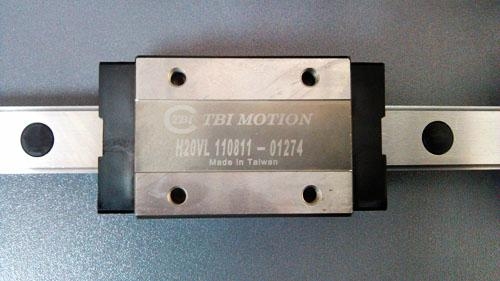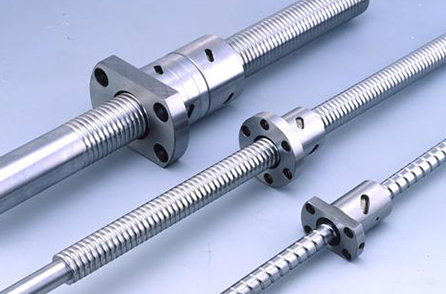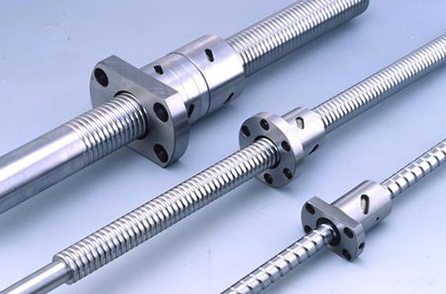丝杠动态扭矩的测量方法解析
来源:http://www.jngongrun.com/ 日期:2025-07-25 发布人:
丝杠动态扭矩是指丝杠在旋转运行过程中所承受的扭转力矩,其大小直接反映丝杠传动系统的运行状态与负载变化,是评估机械传动效率、判断设备故障的重要参数。精准测量丝杠动态扭矩,有助于优化传动设计、减少能量损耗,避免因扭矩异常导致的丝杠磨损、卡顿甚断裂,在机床、精密仪器、自动化生产线等领域应用广泛。
The dynamic torque of a screw refers to the torsional torque that the screw experiences during its rotational operation. Its magnitude directly reflects the operating state and load changes of the screw transmission system, and is an important parameter for evaluating mechanical transmission efficiency and determining equipment failures. Accurately measuring the dynamic torque of the screw helps optimize transmission design, reduce energy loss, and avoid screw wear, jamming, and even breakage caused by abnormal torque. It is widely used in fields such as machine tools, precision instruments, and automated production lines.
动态扭矩测量的核心原理是通过传感元件捕捉丝杠旋转时的扭矩变化,并将力学信号转化为可量化的电信号。当丝杠受到扭矩作用时,其轴体会产生微小的扭转变形(符合胡克定律,在弹性范围内变形量与扭矩成正比),测量这种微小变形即可间接计算扭矩值。常见的传感方式有应变片式、磁电式与光学式 —— 应变片式通过粘贴在丝杠轴体上的应变片感知变形,变形会导致应变片电阻变化,经惠斯通电桥转换为电压信号,具有测量精度高(误差可控制在 ±0.5% 以内)、响应速度快的特点,适合高频动态扭矩测量;磁电式利用磁弹性效应,丝杠轴体在扭矩作用下磁导率发生变化,通过线圈感应磁场变化获取扭矩信号,抗干扰能力强,适合油污、粉尘较多的工业环境;光学式则通过激光干涉测量轴体两端的相对转角,计算扭矩值,测量范围大且无接触,适合高精度、高转速场景(如精密丝杠传动)。
The core principle of dynamic torque measurement is to capture the torque changes during the rotation of the screw through sensing elements, and convert the mechanical signal into a quantifiable electrical signal. When the screw is subjected to torque, its shaft will undergo slight torsional deformation (in accordance with Hooke's law, the amount of deformation is proportional to the torque within the elastic range), and measuring this slight deformation can indirectly calculate the torque value. The common sensing methods include strain gauges, magneto electric sensors, and optical sensors. Strain gauges sense deformation by attaching strain gauges to the screw shaft, which causes changes in the resistance of the strain gauges. The signals are converted into voltage signals by a Wheatstone bridge and have high measurement accuracy (error can be controlled within ± 0.5%) and fast response speed, making them suitable for high-frequency dynamic torque measurement; The magneto electric method utilizes the magneto elastic effect, and the magnetic permeability of the screw shaft changes under the action of torque. The torque signal is obtained through the induction of magnetic field changes by the coil. It has strong anti-interference ability and is suitable for industrial environments with high oil and dust pollution; The optical method uses laser interferometry to measure the relative rotation angle at both ends of the shaft and calculate the torque value. The measurement range is large and non-contact, suitable for high-precision and high-speed scenarios (such as precision screw drive).

常用的测量方法需根据丝杠的安装环境与运行参数选择,确保测量过程不干扰正常传动。在线测量法是将传感器集成到丝杠传动系统中,实时监测运行扭矩,适用于需要持续监控的设备(如数控机床进给系统)。安装时需在丝杠与驱动电机之间加装扭矩传感器(如法兰式传感器),传感器两端通过联轴器分别连接电机输出轴与丝杠输入端,确保同心度(径向跳动不超过 0.1 毫米),避免附加力矩影响测量精度。离线测量法则是将丝杠从设备中拆卸,安装到专用测试平台进行测量,适合设备检修或性能测试,测试平台可模拟不同转速、负载条件(如通过伺服电机驱动丝杠,加载装置施加轴向力),评估丝杠在各种工况下的扭矩特性。对于无法拆卸的大型丝杠(如轧机丝杆),可采用非接触式测量法,通过红外测温或振动分析间接估算扭矩(扭矩异常时丝杠温度或振动频率会发生变化),但精度相对较低(误差约 ±5%),仅作为辅助判断手段。
The commonly used measurement methods should be selected based on the installation environment and operating parameters of the screw to ensure that the measurement process does not interfere with normal transmission. The online measurement method integrates sensors into the screw drive system to monitor the operating torque in real time, and is suitable for equipment that requires continuous monitoring, such as the feed system of CNC machine tools. During installation, a torque sensor (such as a flange sensor) should be installed between the screw and the drive motor. The two ends of the sensor should be connected to the motor output shaft and the screw input end through couplings to ensure concentricity (radial runout not exceeding 0.1 millimeters) and avoid additional torque affecting measurement accuracy. The offline measurement method involves disassembling the lead screw from the equipment and installing it on a dedicated testing platform for measurement, which is suitable for equipment maintenance or performance testing. The testing platform can simulate different speeds and load conditions (such as driving the lead screw through a servo motor and applying axial force to the loading device), comprehensively evaluating the torque characteristics of the lead screw under various working conditions. For large screws that cannot be disassembled (such as rolling mill screws), non-contact measurement methods can be used to indirectly estimate torque through infrared temperature measurement or vibration analysis (the temperature or vibration frequency of the screw will change when the torque is abnormal), but the accuracy is relatively low (with an error of about ± 5%), and it is only used as an auxiliary judgment method.
测量过程中的参数控制与环境适应是保证数据可靠的关键。转速匹配方面,传感器需满足丝杠的转速要求(如普通滚珠丝杠转速通常在 1000-3000 转 / 分钟,高速丝杠可达 5000 转 / 分钟以上),避免因转速过高导致传感器损坏或信号失真。负载模拟需贴合实际工况,测量时施加的轴向负载应与丝杠实际工作负载一致(如机床丝杠需模拟切削力产生的轴向力),负载不稳定会导致扭矩测量值波动,需通过稳压装置或伺服控制系统保持负载平稳。环境因素方面,温度变化会影响应变片、传感器电路的稳定性,测量时需将环境温度控制在 20-30℃(温差不超过 ±5℃),或通过温度补偿电路误差;电磁干扰(如附近有变频电机、电焊机)会干扰电信号传输,需对传感器线缆进行屏蔽处理(如采用屏蔽电缆、接地良好),并远离强电磁源。
Parameter control and environmental adaptation during the measurement process are key to ensuring data reliability. In terms of speed matching, the sensor needs to meet the maximum speed requirements of the screw (such as ordinary ball screws usually have a speed of 1000-3000 revolutions per minute, and high-speed screws can reach more than 5000 revolutions per minute), to avoid sensor damage or signal distortion caused by high speed. Load simulation should be in line with actual working conditions, and the axial load applied during measurement should be consistent with the actual working load of the screw (such as simulating the axial force generated by cutting force on machine tool screws). Unstable load can cause fluctuations in torque measurement values, and stable load should be maintained through a voltage regulator or servo control system. In terms of environmental factors, temperature changes can affect the stability of strain gauges and sensor circuits. During measurement, the ambient temperature should be controlled at 20-30 ℃ (temperature difference not exceeding ± 5 ℃), or errors should be eliminated through temperature compensation circuits; Electromagnetic interference (such as nearby variable frequency motors and welding machines) can interfere with the transmission of electrical signals. Therefore, it is necessary to shield the sensor cables (such as using shielded cables and good grounding) and keep them away from strong electromagnetic sources.
本文由导轨丝杠友情奉献.更多有关的知识请点击:http://www.jngongrun.com真诚的态度.为您提供为的服务.更多有关的知识我们将会陆续向大家奉献.敬请期待.
This article is a friendly contribution from the guide screw For more information, please click: http://www.jngongrun.com Sincere attitude To provide you with comprehensive services We will gradually contribute more relevant knowledge to everyone Coming soon.
- 上一篇:导轨承载方向的确定方法:从受力分析到实际应用
- 下一篇:导轨丝杠相关解析
 导轨丝杠:从设计结构...<>
导轨丝杠:从设计结构...<> 大型丝杠的性能设计介...<>
大型丝杠的性能设计介...<> 梯形丝杠和滚珠丝杠的...<>
梯形丝杠和滚珠丝杠的...<> 滚珠丝杆目前的行业的...<>
滚珠丝杆目前的行业的...<> 滚珠丝杠螺母油封更换...<>
滚珠丝杠螺母油封更换...<>



